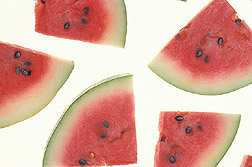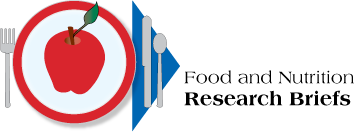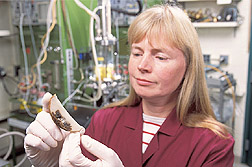This page has been archived and is being provided for reference purposes only. The page is no longer being updated, and therefore, links on the page may be invalid.
| August 2002 |
Zinc’s Antioxidant Potential ProbedZinc may have a key role in keeping cell membranes intact, preliminary results of a new study suggest. This essential nutrient may carry out that chore by functioning as an effective antioxidant, safeguarding the membranes against damage caused by oxidative effects of other minerals such as copper or iron. Cell membranes keep cell contents in place and selectively allow salts or other compounds to flow in and out, as needed. Scientists at the ARS Western Human Nutrition Research Center, Davis, Calif., collaborated with investigators from the University of California’s Berkeley and Davis campuses for the study. The researchers worked with eight healthy men, age 27 to 47, who volunteered for the 20-week experiment. The volunteers ate typical foods at normal mealtimes. For 10 weeks, they received only 4.6 mg of zinc, the amount recommended by the United Nations’ World Health Organization. For a total of another 10 weeks, the men received an additional 9.1 mg of zinc every day. Laboratory tests indicated that study participants’ red blood cell membranes were significantly more fragile when measured after the 10-week low-zinc stint. This cell membrane change occurred in the absence of any overt indicators of zinc deficiency, such as a decline in their blood plasma zinc levels. The findings suggest that cell membrane health may be a sensitive indicator of an individual’s zinc needs. In addition, the findings emphasize the importance of maintaining a good zinc intake. Foods that provide zinc include beans, whole grains, shellfish, red meat, and dark-meat poultry. For more information, contact Janet C. King, (530) 752-5268, USDA-ARS Western Human Nutrition Research Center, Davis, CA Need Lycopene? Have Some WatermelonBesides being fun to eat, watermelon is good for you. It’s a delicious source of lycopene--a health-promoting phytonutrient. 
Now, ARS researchers from Lane, Okla., and Beltsville, Md., are looking into the influence of watermelon genetics on lycopene content. Each of the 13 kinds of watermelon that the researchers analyzed had as much or more lycopene as fresh tomatoes, which are considered a good source (Journal of the Science of Food and Agriculture, 2001, vol. 81, no. 10, pp. 983-987). A related study with 23 volunteers--healthy men and women age 36 to 69--showed that our bodies can readily take up and use lycopene from watermelon. The experiment, in which volunteers drank either tomato or watermelon juice as part of a 19-week research regimen, is likely the first to pinpoint the bioavailability of watermelon’s lycopene. Lycopene, also found in guava, red and pink grapefruit, and tomatoes is an antioxidant that is thought to help protect against cancer and heart disease. For further information, contact Penelope M. Perkins-Veazie, (580) 889-7395, USDA- ARS South Central Agricultural Research Laboratory, Lane, OK or Beverly A. Clevidence, (301) 504-8396, USDA-ARS Phytonutrients Laboratory, Beltsville, MD Sunbutter--Alternative to Peanut ButterA tasty new spread made from sunflower seeds might offer a healthful option for people who--because of allergies--can’t eat peanut butter. About 3 million Americans are allergic to peanuts or certain tree nuts, according to estimates from the American Academy of Allergy, Asthma, and Immunology.
Sunflower seeds provide protein, fiber, vitamin E, zinc and iron. For more information, contact Isabel Lima, (504) 286-4515, USDA-ARS Southern Regional Research Center,New Orleans, LA Formative Food Choices ExaminedWhen do we begin forming our preferences for certain foods? Perhaps as early as infancy. A new study at the ARS Children’s Nutrition Research Center, Houston, Texas, may reveal whether that’s the case. Some 44 Houston-area moms and their 3- to 12-month-old infants will participate in this unique investigation. To learn more, scientists will work with new mothers to find out how their babies’ food preferences change through 12 months of age. The research team will also follow babies’ growth over the course of the study. Findings may help parents establish healthy eating patterns for their children. For more information, contact Jennifer O. Fisher, (713) 798-6766, USDA-ARS Children’s Nutrition Research Center at Baylor College of Medicine, Houston, TX Age, Gender Impact Homocysteine’s Heart-Attack RiskAn analysis of health data from nearly 8,400 American men and women provides new insight into the link between high levels of the amino acid homocysteine and increased risk of heart attack and stroke. The research may also help explain why the link has not always shown up in earlier studies.
ARS-funded scientists at the Jean Mayer USDA Human Nutrition Research Center on Aging in Boston, Mass., reached these conclusions from their analysis of data about men and women, age 17 to over 70 years, who participated in the third National Health and Nutrition Examination Survey, or NHANES III. Homocysteine can build up to high levels in people who do not get enough B vitamins, most notably folate. The body uses these nutrients to convert homocysteine into harmless compounds. Smoking, high blood pressure and consuming too much alcohol or caffeine can also lead to high homocysteine. Eating grain products fortified with folate can help keep homocysteine at healthy levels. The researchers published their findings in the Journal of Nutrition (2000, vol. 130, no. 6, pp. 3073-3076) For more information, contact Jacob Selhub, (617) 556-3191, Jean Mayer USDA Human Nutrition Research Center on Aging at Tufts University, Boston, MA Helpful Bacteria Battle Tuber Dry Rot, SproutingBeneficial soil-dwelling bacteria may protect tomorrow’s potatoes against dry rot fungus and unwanted sprouting. Strains of friendly Pseudomonas and Enterobacter bacteria, harmless to humans, can form a biological “bandage” to prevent the primary dry rot fungus, Fusarium sambucinum, from sneaking into spuds via nicks and cracks in the tubers’ skin.
The bacteria may prove an effective alternative to chemical fungicides. What's more, the microbes may thwart sprouting of stored spuds. Several strains stopped tubers’ sprouting by 40 to 70 percent, the researchers report. For more information, contact Patricia J. Slininger, (309) 681-6596, USDA-ARS National Center for Agricultural Utilization Research, Peoria, IL Benefits of High-Carb Meals DocumentedAmericans who eat meals high in carbohydrate may consume less fat, carry less fat on their bodies, and achieve more of the daily recommended intakes for essential nutrients. That’s in contrast to people who eat fewer carbs in relation to protein and fat. Scientists at the ARS Beltsville Human Nutrition Research Center found this out in their analysis of data from the U.S. Department of Agriculture’s 1994-1996 Continuing Survey of Food Intakes by Individuals. The researchers evaluated the amounts of carbohydrate, fat and protein consumed by 10,014 adult men and women. The scientists published their conclusions in the June 2002 issue of the Journal of the American College of Nutrition (vol. 21, no. 3, pp. 268-274). For purposes of this study, adults were considered high-carb eaters if carbohydrate made up 55 percent or more of their total daily calories. This carbohydrate came from such foods as bread, pasta, rice, fruits and vegetables. More individuals in the high-carb group had Body Mass Index, or BMI, scores closer to recommended targets than did survey particiapants who consumed fewer carbs. A BMI score can indicate whether an individual’s weight is normal. For more information, contact Shanthy A. Bowman, (301) 504-0619, USDA-ARS Beltsville Human Nutrition Research Center, Beltsville, MD Faster-Cooking Brown Rice AheadBrown rice that used to require up to 50 minutes to cook now can be tender and ready to eat in only 15, if processed by a novel technique. ARS scientists in New Orleans, La., developed the procedure. The reduced cooking time makes this nutritious food more convenient to serve and should thus increase its appeal.
The researchers are working with food-processing industry specialists to further develop the innovative procedure. Brown rice, which is simply white rice with its outer layer still in place, is a source of fiber, thiamine, niacin, vitamin B6, magnesium, zinc and several other nutrients. For more information, contact Harmeet S. Guraya, (504) 286-4258, USDA-ARS Southern Regional Research Center, New Orleans, LA Study Analyzes Calcium, Protein, and Healthy BonesScientists don’t yet know for certain whether a high-protein regimen leaches calcium from our bones. But ARS-funded researchers at the Jean Mayer USDA Human Nutrition Research Center on Aging at Tufts University, Boston, Mass., have now provided new data on this subject. In a 3-year study with more than 300 men and women over age 65, the scientists found that, on average, there was no loss in bone among volunteers who ate meals high in protein as long as they took a daily supplement of calcium and vitamin D. The supplements ensured that they met their daily Recommended Dietary Intake of these nutrients. Vitamin D is known to enhance calcium absorption. In contrast, a higher protein intake did not appear to protect against bone loss in volunteers who were not taking calcium and Vitamin D supplements. Details are in the April 2002 issue of the American Journal of Clinical Nutrition (vol. 75, no. 4, pp. 773-779). For more information, contact Bess Dawson-Hughes, (617) 566-3064, Jean Mayer USDA Human Nutrition Research Center on Aging at Tufts University, Boston, MA Teens: Breakfast Is Good for You!Teens who eat breakfast are two to five times more likely than their breakfast-skipping counterparts to get at least two-thirds of the daily Recommended Dietary Intakes of vitamins A, D, B2, B6 and folate; and of minerals such as calcium, iron, magnesium and phosphorus. Too, breakfasting teens consume less fat and get higher amounts of protein and carbohydrates. In contrast, breakfast-skippers consume higher amounts of fat. These finding are from a new study of more than 700 ninth-graders in New Orleans, La. Scientists at the ARS Children’s Nutrition Research Center at Baylor College of Medicine, Houston, Texas, describe the research in the Journal of Adolescent Health, 2002 (vol. 27, no. 5, pp. 314- 321). The study updates earlier investigations which had shown that teens who skip breakfast make poorer food choices, are unlikely to compensate for missed nutrients by the end of the day, and are more likely to have a higher Body Mass Index, or BMI. A high BMI is often indicative of overweight. During the past 25 years, more and more Americans--especially 15- to 18- year-old females--have chosen to skip breakfast. For more information, contact Theresa A. Nicklas, (713) 798-6766, USDA-ARS Children’s Nutrition Research Center at Baylor College of Medicine, Houston, TX Biotechnologists Bolster Tomato Lycopene LevelsTomatoes richer in the antioxidant lycopene have been developed by ARS and Purdue University biotechnologists. A serving of one to two of the high-tech tomatoes provides the 10 milligrams of lycopene that some nutritionists recommend we consume daily. In contrast, about 10 or more conventional tomatoes are needed to provide this same quantity of lycopene.
The researchers are seeking industry partners to commercialize the new tomatoes. For more information, contact Autar K. Mattoo, (301) 504-7380, USDA-ARS Vegetable Laboratory, Beltsville, MD Counteracting Kids’ Cholesterol CountsKids’ cholesterol levels could affect their health later in life, according to scientists from the ARS Children’s Nutrition Research Center at Houston, Texas. Researchers tested the cholesterol levels and recorded foods eaten by 1,182 children at one point when the kids were third graders and once again when they were in the fifth grade. The scientists found that total cholesterol closely correlated with the amount of fat that youngsters consumed. The researchers note that reducing the amount of saturated fat that children eat, increasing the amounts of fruits and vegetables they are served, and encouraging them to exercise should help keep their cholesterol counts at healthy levels. An article in the April 2002 Journal of the American Dietetic Association (vol. 102, pp. 511-517) has details. For more information, contact Theresa A. Nicklas, (713) 798-6766, USDA-ARS Children’s Nutrition Research Center at Baylor College of Medicine, Houston, TX |
|
The United States Department of Agriculture (USDA) prohibits discrimination in all its programs and activities on the basis of race, color, national origin, gender, religion, age, disability, political beliefs, sexual orientation, and marital or family status. (Not all prohibited bases apply to all programs.) Persons with disabilities who require alternative means for communication of program information (Braille, large print, audiotape, etc.) should contact USDA's TARGET Center at 202-720-2600 (voice and TDD). To file a complaint of discrimination, write USDA, Director, Office of Civil Rights, Room 326-W, Whitten Building, 14th and Independence Ave., SW, Washington, DC 20250-9410 or call 202-720-5964 (voice or TDD). USDA is an equal opportunity provider and employer. |


 ARS scientists at the Southern Regional Research Center, New Orleans, La., worked with colleagues at Red River Commodities, Inc., Fargo, N.D., to develop a better way to process the sunflower seeds. Their technique captures the unique, nut-buttery taste when blended with ingredients needed to make a spreadable product. The company officially unveiled their product at the Institute of Food Technologists annual meeting in June.
ARS scientists at the Southern Regional Research Center, New Orleans, La., worked with colleagues at Red River Commodities, Inc., Fargo, N.D., to develop a better way to process the sunflower seeds. Their technique captures the unique, nut-buttery taste when blended with ingredients needed to make a spreadable product. The company officially unveiled their product at the Institute of Food Technologists annual meeting in June. For men over 40, the correlation between high levels of homocysteine in blood (greater than 12 micromoles per liter) and high risk of vascular disease began to decline with age. Among women over 40, a strong link between high homocysteine and high risk was found only in those who were post-menopausal.
For men over 40, the correlation between high levels of homocysteine in blood (greater than 12 micromoles per liter) and high risk of vascular disease began to decline with age. Among women over 40, a strong link between high homocysteine and high risk was found only in those who were post-menopausal. Preliminary tests by scientists based at the ARS National Center for Agricultural Utilization Research, Peoria, Ill., indicate that spraying potatoes with the bacteria can reduce rot by 59 percent or more.
Preliminary tests by scientists based at the ARS National Center for Agricultural Utilization Research, Peoria, Ill., indicate that spraying potatoes with the bacteria can reduce rot by 59 percent or more. The ARS technique requires air-blasting the brown rice kernels with rice flour at the processing plant. That leaves microscopic holes that allow the rice to more readily absorb water during cooking--and become tender sooner. The technique doesn’t harm the taste or texture of the grains, scientists attest.
The ARS technique requires air-blasting the brown rice kernels with rice flour at the processing plant. That leaves microscopic holes that allow the rice to more readily absorb water during cooking--and become tender sooner. The technique doesn’t harm the taste or texture of the grains, scientists attest. Researchers found that genetically engineering tomatoes to boost levels of naturally occurring compounds called polyamines increased the tomatoes’ lycopene levels. Their work, published in the June 2002 issue of Nature Biotechnology (vol. 20, no. 6, pp. 613-618), is the first to show a link between high levels of polyamines and enhanced lycopene content.
Researchers found that genetically engineering tomatoes to boost levels of naturally occurring compounds called polyamines increased the tomatoes’ lycopene levels. Their work, published in the June 2002 issue of Nature Biotechnology (vol. 20, no. 6, pp. 613-618), is the first to show a link between high levels of polyamines and enhanced lycopene content.